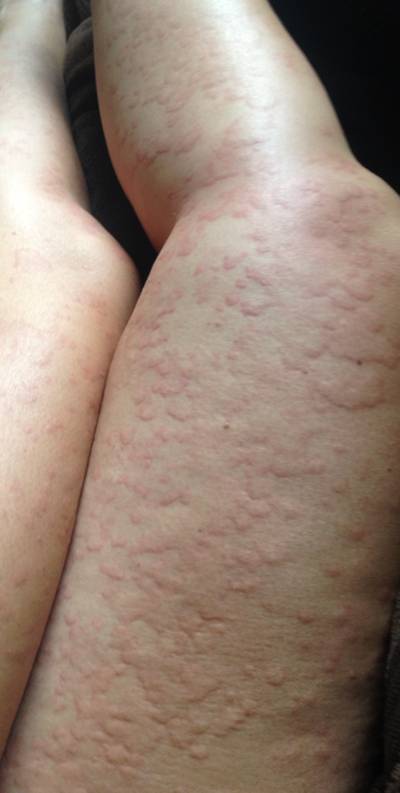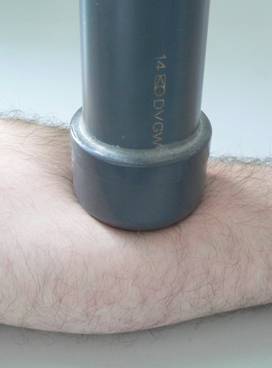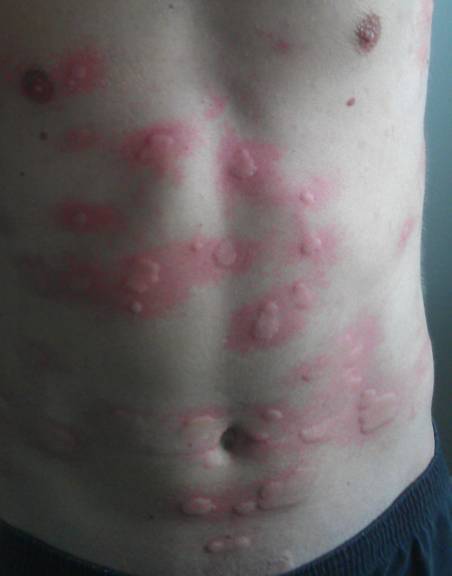2. Urticaria self-test
What kind of urticaria do I have?
Markus Magerl
Survey
Distinguishing the various forms of urticaria is of practical importance as, among others, the prognosis and type of treatment depend thereupon. Thereby it is important to know that you can also suffer from two or several forms of urticaria. The most frequent concomitant disease of urticaria is another form of urticaria. You can test which form(s) of urticaria you have with the help of the following ten questions Please read each question with due care and then decide on your answer. You will find the respective relevant answers at the end of the questions part.
Questions
My wheals and/or angioedema appear out of the blue, i.e. without any special trigger and without being able to predict when an attack will happen.
Yes NoNo urticaria
In all likelihood you have no urticaria. Common diseases associated with changes to the skin (not wheals) and itchiness include atopic eczema or prurigo. One should also consider the possibility of a parasite infestation (fleas, bed bugs, mites). The causes of itchiness without clear visible skin changes are extraordinarily varied: diabetes mellitus, renal failure, liver diseases, hypothyroidism, allergies, tumours or blood diseases can all lead to itchiness. In most cases, however, the itchiness can be directly related to excessively dry skin. Regular application of moisturising creams and lotions, particularly following the taking of showers and baths, is often effective treatment in these cases.
Back to chapter overviewChronic spontaneous urticaria
If your wheals and itchiness and/or swelling of the skin came “out of the blue” and have been occurring for more than 6 weeks, i.e. there is no certain and obvious trigger for your symptoms and you cannot provoke or predict an outbreak of wheals, then in all likelihood this is a case of chronic urticaria (Ill. 6).

Illustration 6: Manifestation of wheals on the legs. The random arrangement of the wheals is particularly observed in the spontaneous forms of urticaria. (Source: www.urtikaria.net)
More information about the clinical picture of this disease is found in Chapter 3.1.2 . If your symptoms sometimes or often, yet not exclusively, occur “out of the blue”, but can also be provoked, go to Question 4 to check whether another form of urticaria may be involved apart from a chronic spontaneous urticaria.
Back to chapter overview
Acute spontaneous urticaria
If the wheals and itchiness and/or swelling of the skin have been occurring for less than 6 weeks, but “out of the blue”, then in all likelihood acute spontaneous urticaria is concerned (Ill. 6). You find more information about this clinical picture in Chapter 3.1.1 .

Illustration 6: Manifestation of wheals on the legs. The random arrangement of the wheals is particularly observed in the spontaneous forms of urticaria. (Source: www.urtikaria.net)
Back to chapter overview
Symptomatic dermographism / Urticaria factitia
If your wheals often take the form of stripes and exclusively appear in places where you have just scratched or rubbed yourself, then in all likelihood you are suffering from symptomatic dermographism (urticaria factitia). You find more information about this clinical picture in Chapter 3.2.1 . If your symptoms sometimes or often, but not exclusively appear after scratching or rubbing the skin go to Question 5 to check whether another form of urticaria may be involved.
Back to chapter overview
Cold urticaria
If the wheals and itchiness occur during contact with cold (or shortly after exposure to cold) and only on the spot exposed to the cold, then “Cold urticaria” is the most likely diagnosis. Cold urticaria is a common form of inducible urticaria. You find further information about this clinical picture in Chapter 3.2.2 . If your symptoms sometimes or often appear after skin contact with cold, but also now and then without the skin having had contact with cold, go to Question 6 to check whether another form of urticaria might also be involved in addition to cold urticaria.
Back to chapter overview
Solar urticaria
If the angioedema or wheals and itchiness exclusively appear on the patches of skin exposed to light, i.e. the symptoms depend on light irradiation (particularly direct solar irradiation) then solar urticaria is the most likely diagnosis. Solar urticaria is one of the less common forms of inducible urticaria. You find more information about this clinical picture in Chapter 3.2.4 . If your symptoms sometimes, or often but not exclusively, appear following exposure to light, go to Question 7 to check whether another form of urticaria might also be involved in addition to solar urticaria.
Back to chapter overview
Pressure urticaria
You are possibly suffering from pressure urticaria. It is important to note the “pressure” does not refer to rubbing or scratching in this case (as is the case in symptomatic dermographism), but occurs as a result of uniform pressure applied to one spot, such as the kind applied to the shoulders by the straps of a backpack or to the feet when standing on a ladder – also delayed even after several hours (Ill. 7).

Illustration 7: Pressure stamp test when suspecting pressure urticaria (Source: Allergy Centre Charité)
You find further information in Chapter 3.2.3 . If your symptoms sometimes or often but not exclusively, appear following exposure to pressure, go to Question 8 to check whether another form of urticaria might also be involved in addition to pressure urticaria.
Back to chapter overview
Heat urticaria
If wheals and itchiness appear after contact with heat (e.g. a hot water bottle, a hot car seat in summer), then heat urticaria is likely to be the diagnosis. Heat urticaria is a very uncommon form of induced urticaria. Heat urticaria involves the development of wheals and itchiness typical for urticaria after exposure to heat, but only on the patch of skin exposed. This is clearly different from cholinergic urticaria when wheals appear after increase of core body temperature (e.g. sports, visit to the sauna but also emotional stress etc.). Only little research has been made into heat urticaria, but it is known that it responds to antihistamines. If your symptoms sometimes or often, but not exclusively, appear following exposure to heat, go to Question 9 to check whether another form of urticaria might also be involved in addition to heat urticaria.
Back to chapter overview
Cholinergic urticaria (sweat-induced urticaria)
If you always suffer from wheals and itchiness when you feel warm (all over), be it actively from sports, emotion stress such as excitement or passively by taking a bath or eating spicy food, then in all likelihood you are suffering from cholinergic urticaria. It is a common form of urticaria and is sometimes also called “Cholinergic urticaria” or “sweat-induced urticaria”. Patients with cholinergic urticaria suffer from wheals and itchiness whenever body temperature increases. The wheals are often small to begin with, however then join up and often only last for a few minutes. You find further information in Chapter 3.2.5 . If your symptoms sometimes or often, but not exclusively, appear during exertion, excitement or when sweating, go to to check whether another form of urticaria might also be involved in addition to cholinergic urticaria.
Back to chapter overview
Contact urticaria
If you always get wheals and itchiness in places where your skin comes into contact with specific materials or substances, then in all likelihood you are suffering from contact urticaria. The most common form of contact urticaria is the urticaria appearing after touching stinging nettles. The histamine contained in the stinging hairs of the plant is released upon contact and the typical burning wheals appear. This reaction of the skin is completely normal and harmless and can be triggered in any human. This contact urticaria is neither an illness nor an allergy, rather a normal reaction of the skin.
It is different in the case of allergic contact urticaria. Numerous natural and artificial materials can cause an allergy that then expresses itself by contact urticaria. Allergies to foods are of particular importance here. If a food allergy develops into contact urticaria, then the handling of foods leads to wheal formation at place of contact, meaning that the hands are often affected when preparing food or – much more serious – the mucous membranes when eating. Food allergies expressed by contact urticaria can be very dangerous due to potential swelling in the throat area, and under some circumstances can even trigger anaphylaxis. These food allergies are often related to carrots, celery or other vegetables, apples peanuts and hazelnuts or drupes (stone fruit). Where a contact urticaria from foodstuffs is suspected, extensive allergy testing must ensue.
Contact with animal hair can also lead to allergic wheal formation. Dog and cat hair are the prime culprits. Unfortunately the removal of the animal has to be recommended, although in some cases it may be sufficient to change the way the animal is kept. Latex and latex allergies can also be a cause of contact urticaria. Because no causal treatment is possible for latex allergies, all contact with latex materials must be strictly avoided – often not an easy task. Many cross-allergies to foods such as avocado, banana etc. are known. It is very rare that perfumes, shower gels or cosmetics are responsible for wheals and itchiness. This would only then be the case if the substance leads to wheals and itchiness very soon after application and only at the spots where it came into contact with the skin. If the substance is not applied, no wheals should appear. The same applies to detergents and fabric softeners and to medicinal creams.
Very rarely the contact with water leads to itching wheals (aquagenic urticaria). It is not possible to be allergic to water itself, after all humans consist of over 70 % water. Possibly water acts as a solvent for allergens found on or in the skin, and can only penetrate further into the skin after contact with water.
Back to chapter overview
Chronic spontaneous urticaria or another disease?
If your changes of the skin and symptoms cannot be provoked by the triggers named, it has to be clarified whether wheals and/or angioedema are really concerned as they were described in the introduction (s. Chap. 1 ) or whether another skin change is concerned. When we are sure that your skin appearances are wheals which have not been triggered and recurrently by one of the stimulants mentioned so far, but you nevertheless feel that the bouts do not occur incidentally, spontaneous urticaria may be involved. There are different stimulants which can cause a bout, but do not do so reliably. Usually drugs are concerned (particularly pain killers) or food (also such food as is generally described as being “healthy”). You find further information in Chapter 3.1.1 if the symptoms have lasted less than 6 weeks, if the symptoms last longer than 6 weeks in Chapter 3.1.2 . diminish the threshold to a pending urticaria bout resulting in wheals/angioedema developing quicker or more intensely (Ill. 8).

Illustration 8: Wheals on the torso of spontaneous urticaria patients (Source: www.urtikaria.net)
Stress and emotional strain furthermore lead to a changed self-perception and to greater strain. Wheals which do not itch (or only slightly), but rather burn and for longer than 24 hours and remain at the same spot, sometimes leave pigmentations or long-lasting wheals which only respond to systemic corticosteroids have to be separately clarified at the dermatologist’s. In such cases a skin biopsy is required. Before the biopsy the actual duration of the wheals has to be checked. Further clarification is also necessary if the skin changes are regularly accompanied by bouts of fever and/or joint pain, particularly if several members of your family also suffer from these symptoms.
Back to chapter overview






 English
English Deutsch
Deutsch Francais
Francais Español
Español



